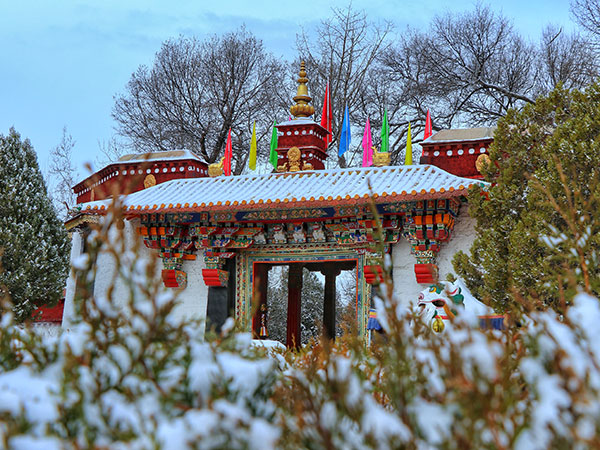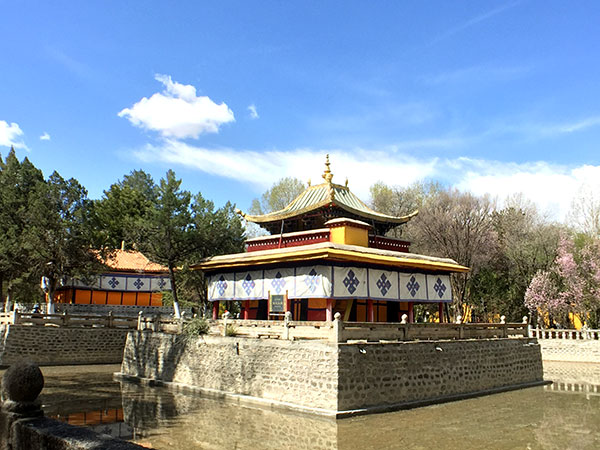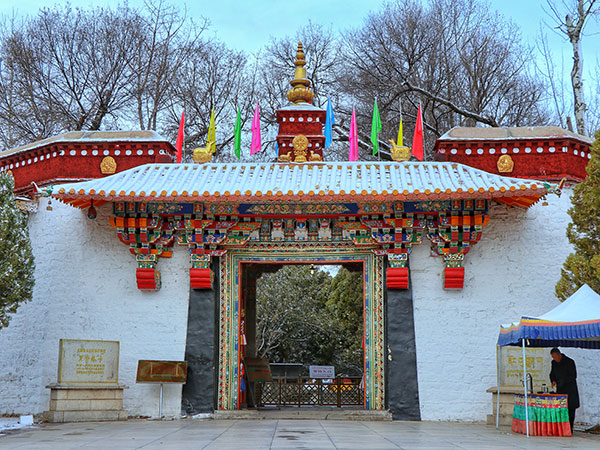Norbulingka means Jewel Garden. First built in 1751, it borrowed architectural style from the inland areas of China while maintaining local ethnic and religious features. Norbulingka served as a traditional summer palace and residence starting with the 7th Dalai Lama, and now it is the largest garden in Tibet.
The earliest building is the Gesang Pozhang Palace built by Kelzang Gyatso. The ‘New Palace’ was begun in 1954 by the present Dalai Lama and completed in 1956. It contains chapels, gardens, fountains and pools. To the west the Kalsang Potang built by Seventh Dalai Lama is ‘a beautiful example of Yellow Hat architecture. Its fully restored throne room is also of interest.’
The garden is a favorite picnic spot and provides a beautiful venue for theatre, dancing and festivals, particularly the Sho Dun or ‘Yoghurt Festival’, at the beginning of August, with families camping in the grounds for days surrounded by colourful makeshift windbreaks of rugs and scarves and enjoying the height of summer weather. There is also a zoo at Norbulingka, originally to keep the animals which were given to the Dalai Lama. Heinrich Harrer helped the 14th Dalai Lama build a small movie theatre there in the 1950s.
Norbulingka is located 3km west of the Potala Palace which was the winter palace. Additional buildings were added to the park during the first half of the 20th century. In 2001, UNESCO inscribed Norbulingka on its World Heritage Site as part of the ‘Historic Ensemble of the Potala Palace’.
Architectural Characteristic
Norbulingka is the largest and the best scenery of Tibet artificial gardens, whose architecture features are: buildings in the higher place and pool in the lower place, the whole layout is built according to nature. Norbulingka trees are lush with green leaves, Central Lake P
alace, the Dragon King Pavilion, Golden Lingka of Tibetan style buildings partly hidden ad partly visible among the lush trees. The fresh air, quiet environment has a kind of Tibetan landscape characteristic of natural and unadorned.
Constitutes and Layout
Norbulingka consists of Kelsang Phodrang, Tsokyil Phodrang, Golden Lingka and Takten Migyur Phodrang. Each palace is divided into three areas – the palace area, the area in front of the palaces and the woods. As the main body of Norbulingka building complex, Kelsang Podrang is located in the southeast of the second wall in the south courtyard. The building complex with Tsokyil Phodrang as the main body is located in chapter he is about 120 meters northwest, is the most beautiful scenic spots in the Norbulingka. The building complex with Golden Lingka as the main body is located in western Norbulingka. Groups of buildings are built of wood and stone as the main materials, the planning is tidy and has obvious Tibetan architectural style. Inside the main hall, its walls are painted with exquisite frescoes. In addition, within the Norbulingka there also collects a large number of cultural relics and books.
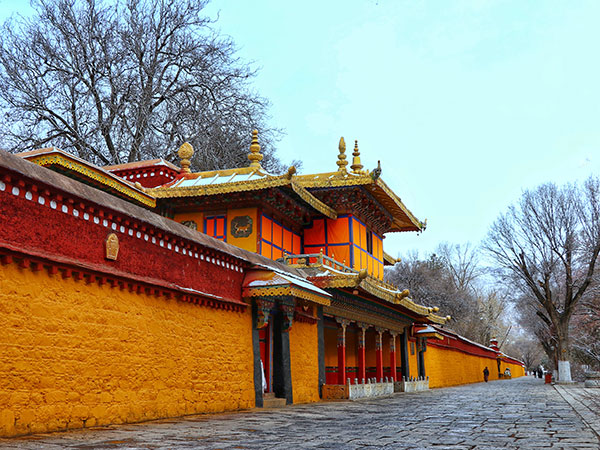
Kelsang P
ho
drang, named after the Seventh Dalai Lama (Kelsang Gyatso), which is a three-storey palace with chambers for worshipping Buddha, bedrooms, reading rooms and sanctuaries. From the north gate and walk along a straight road forward 200 meters, on the left of the road there is a 500 square meters space, which is
the place for performing Tibetan opera that is theatrical stage. The opposite is
Khamsum Zilnon
, a two-storey pavilion, which was a Han architecture style pavilion originally, and rebuilt into a pavilion for Dalai Lama enjoyed Tibetan opera
. In the northeast of Khamsum Zilnon is a Lakhang for religious ceremonies. The 8th Dalai Lama, Jamphel Gyatso substantially enlarged the palace by adding three temples and the perimeter walls on the south east sector and the park also came to life with plantation of fruit trees and evergreens brought from various parts of Tibet.
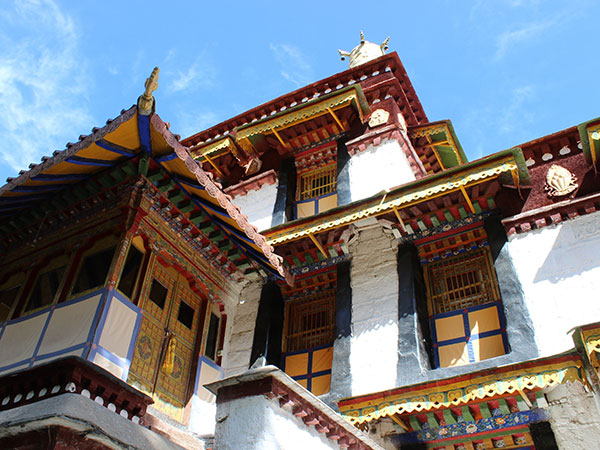
Tsokyil Phodrong, which is a pavilion in the midst of a lake and it is also known as Lake Palace. During the eighth Dalai Lama period, Tsokyil Podrang is regarded as the most attractive architecture in Norbulingka. To the west of Norbulingka is the Golden Lingka
, which was built by a rich benefactor in 1922 during the Thirteenth Dalai Lama period. At the same time, quantities of flowers, grass and trees were planted as well as a cluster of buildings. The 13th Dalai Lama, in addition to being in charge for altering architecture, he also improved the
Chens
il
Phodrang garden on the northwest. On the north of Tsokyil Phodrang is the New Summer Palace of 14th Dalai Lama, also called
Takten Migyur Ph
od
rang, which is built in 1954, means “Eternal Palace” in Tibetan. Although New Palace is a modern architecture, it is the traditional style in its appearance. It has combined the characteristics of temple and villa and is more magnificent than other palaces. On the west side of small scripture hall is 14th Dalai Lama’s bedroom, there is bed and two seats, and the furnishing layout is the same as the past.
History and Development
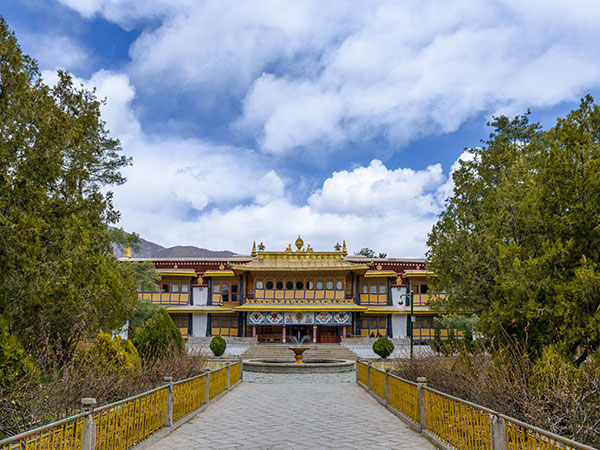
The construction of Norbulingka started from 7th Dalai Lama who built the first building of Norbulingka and completed during 14th Dalai Lama period that built Takten Migyur Phodrang., lasted for more than 200 years. Before 1740s, Norbulingka was a wasteland that beast haunted, and full of weeds and dwarf willows. Later, as a result of 7th dalai like here and often come to this place, so at that time the minister of the Qing dynasty in Tibet built a phodrang– pavilion palace for him. The palace and garden was undertaken by the 7th Dalai Lama from 1755. The Norbulingka Park and Summer Palace were finished in 1783 by the Jampel Gyatso, the 8th Dalai Lama, on the suburb of Lhasa. And it has become the summer residence during the reign of the Eighth Dalai Lama. Norbulingka originally was shrub, was the place Lhasa River Old Course flowed through. Here the riverway is twisted, flowed gently, and summer grass and willow in the bank reflected on the river, which was very beautiful. The initial history of Norbulingka is traced originally to a spring at this location, which was used by the 7th Dalai Lama to cure his health problems by take bath every summer. Qing Dynasty imperial minister stationed in Tibet permitted the Dalai Lama to build a special palace at this location to rest after taking bath. Therefore, the first construction of Norbulingka—the Pavilion Palace appeared. In A.D. 1751, 7thDalai built a three-storey palace in the east of Pavilion Palace, named after his name Kelsang Phodrang (Xianjie Palace), inside there are Buddhist prayer room, bedroom, reading room and protectors temple, assembly hall, etc. After completion in 1755, approved by the emperor Yongzheng of Qing dynasty, 7th dalai would deal with government affairs in Kelsang Phodrang every summer, and after being used by latter dalai, here is also used as office to meet with Tibetan monks officials in summer. Since then, Norbulingka gradually changed into summer palace for dealing with penalty and civilized intercourse from health resort. And subsequent Dalai Lamas also used to stay here to study (before enthronement) on March 18
th every summer in Tibetan calendar, and come back to Potala Palace during September and October. Thus, Norbulingka is also known as the Summer Palace of the Dalai Lama. The 8th Dalai Lama was responsible for expansion of the Norbulingka complex in the form of palaces and gardens. He extended Chensil Phodrang (reading room), Khamsum Zilnon, sermon institution and excavated the original ponds into lakes. He built a Dragon King Temple and Tsokyil Phodrang (Lake Palace) in the center of lake according to Han architecture style. 1922, 13th dalai renewed Norbulingka, on the west side of garden constructed Golden Phodrang, Kelsang Deji Palace, etc, and built Golden Lingka in the southwest, and planted many trees and flowers. In 1954, the fourteenth Dalai Lama was built Takten Migyur Phodrong (eternal palace) in the central garden, also built a new palace in the north, made Norbulingka developed to the existing scale. The Norbulingka after management of successive Dalai Lama is now a tourist attraction. It has various palace building, villas, a pavilion, waterside pavilion, and a large number of trees and flowers, and covers an area of 360000 square meters.The palace has a large collection of Italian chandeliers, Ajanta frescoes, Tibetan carpets and many other artifacts. Murals of Buddha and the 5th Dalai Lama are seen in some rooms. Norbulingka has become the open park and the museum for people to visit and hold various festival fete and vacation activities. The 14th Dalai Lama’s (who fled from Tibet and took asylum in India) meditation room, bedroom, conference room and bathroom are part of the display explained to the tourists.
Tourism Characteristics
• Sholton Festival Annual Sholton Festival in Lhasa, Norbulingka is one of the activity centers of Lhasa, and the famous Tibetan opera group around Lhasa will flock to here. From July the first to the seventh in the Tibetan calendar, these seven days in here, every day will perform Tibetan opera. And on the eve of the Sholton Festival, Norbulingka and the surrounded woods, transformed into a colorful “tent city” overnight. These tents are Tibetans come to Norbulingka and build a temporary “home”. Tent cities also formed a few unique, lively festival markets, people seem to move the whole Lhasa city into the green world. As it were, Sholton Festival is the day when people are the most vital and energetic in Lhasa. During the holiday, almost Lhasa citizens are out of home, all dressed in colorful holiday tradition clothing. Families, relatives and friends in groups put up tents on the grass below shade, sit together surrounded the tent, and place barley wine, tea, snack foods, such as Tibetan food from home to drink and chat, play chess and cards, sing and dance. When the Tibetan opera is beginning, the crowd will round into a circle to enjoy the Tibetan opera actor’s wonderful performance.
• Tibetan Opera After the ceremony, everyone will run into Norbulingka, only in this festival, Norbulingka is free. And there are ring throwing, shooting, archery, and horse-riding for play and so on.
Tibetan opera is the main program, of course, you can see from morning until 5 o ‘clock in the evening, within a week, the Tibetan opera basically will not repeat in the Norbulingka, this is also the strongest squad team, the richest content, the most powerful performance in Lhasa Tibetan opera performances throughout the year.
Travel Guide of Norbulingka
【How to get to Norbulingka】 taking bus No.2 and 14 to Norbulingka South Station
【Best time to travel Norbulingka】it is suitable to travel all year round.

